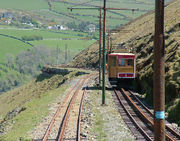Snaefell Mountain Railway
2007 Schools Wikipedia Selection. Related subjects: Railway transport
The Snaefell Mountain Railway is an electric mountain railway connecting the town of Laxey with the summit of Snaefell which is, at 2036 feet (620.6 m) above sea level, the highest point on the Isle of Man. The Snaefell Mountain Railway connects with the Manx Electric Railway in Laxey.
Operation
The line is five miles (8 km) long, built to 3 ft 6 in (1067 mm) gauge and uses the unusual Fell centre rail for braking on the steep gradients. The line is electrified using overhead line at 550 volts direct current, using a bow collector.
Services run between April and September and operate at regular intervals taking 30 minutes for a one-way journey. There is no winter service and during the winter period the overhead wires on the exposed upper part of the route are dismantled to avoid damage caused by excessive icing.
All passenger traffic is carried in six wooden-bodied electric railcars, built in 1895 and numbered 1 to 6. Car 5 was burnt out in an accident in 1970 and the body it now carries is a replacement built in 1971 to a similar design. All six cars were re-equipped in the late 1970s with newly built bogies to a design based on the original, and using motors and traction equipment taken from withdrawn trams that formerly ran in Aachen.
Because of the different gauge and centre rail, railway vehicles cannot inter-run between the Snaefell Mountain Railway and the Manx Electric Railway. Snaefell Mountain Railway vehicles are occasionally worked to the Manx Electric Railway workshops at Douglas by swapping their bogies, and to aid this there is a dual gauge siding in Laxey.
The Snaefell Mountain Railway is owned and operated by Isle of Man Transport, a department of the Isle of Man government.
History
The line was originally surveyed by George Nobel Fell, the son of John Barraclough Fell who invented the Fell system. This survey was for a steam-operated railway using the Fell centre rail for both propulsion and braking, and the scheme was approved by Tynwald in 1888 but not built at that time.
In 1895 the Snaefell Mountain Railway Association (SMRA) revived the plans, and adopted the route of the earlier survey. As the line was built entirely on land leased by the association, there was no need for statutory powers to be gained and the line was constructed very quickly and opened on 20 August 1895. The line was built from scratch as an electric railway, and the cars were never fitted with Fell traction equipment, instead relying on normal rail adhesion for propulsion up the steep gradients. However the cars were fitted with Fell braking equipment for use when descending the same gradients.
In December 1895 the SMRA sold the line to the Isle of Man Tramways & Electric Power Co. Ltd. (IoMT&EP) which already owned the Manx Electric Railway. However doubt was thrown on this transaction in aftermath of the later collapse of the IoMT&EP, when it was revealed that the SMRA was unregistered, and that most of the board of the IoMT&EP were also members of the SMRA and had voted on the acquisition in contravention of that company's articles of association.
The IoMT&EP went into liquidation in 1900 as a consequence of a banking collapse. The Snaefell Mountain Railway and the Manx Electric Railway were sold by the liquidator to the newly formed Manx Electric Railway Co. Ltd., which took over the services in 1902. By the late 1950s the Manx Electric Railway Co. Ltd. was itself in financial difficulties, and the company and its assets were acquired by the Isle of Man government in 1957.
Tram stations and stops
- Laxey
- Bungalow
- Snaefell summit

